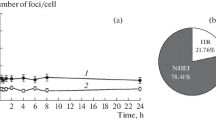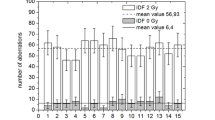Abstract
A Chinese hamster cell mutant has been isolated which is extremely sensitive to killing by γ-irradiation in the G1, and early S phases of the cell cycle (LD50 of 20 vs. 250 rads for parent), but which has nearly normal resistance in late S. The mutant cell is able to repair single-stranded DNA breaks introduced by γ-radiation. However, in comparison to its parental cell, the mutant is deficient in the repair of double-stranded DNA breaks produced by γ-irradiation during the sensitive G1-early S period, while in the resistant late S period, the repair is nearly the same for both cell types. This correlation between γ-ray sensitivity and repair strongly suggests that an inability to repair double-strand DNA breaks in G1 is the basis for the hypersensitivity of the mutant to killing by γ-rays in this phase of the cell cycle. It also provides direct evidence in mammalian cells that the ability to repair double-strand DNA breaks induced by ionizing radiation is an important biochemical function in cell survival and supports the hypothesis that unrepaired double-strand breaks are a major lethal lesion in mammalian cells. A plausible explanation for the appearance of the cell cycle phenotype of the mutant is that in normal cells there are at least two pathways for the repair of double-strand breaks, one of which functions primarily in late S phase, and the other, either throughout the cell cycle or only in the G1 and early S phases.
Similar content being viewed by others
Literature cited
Cerutti, P.A. (1974).Naturwissenschaften 61:51–59.
Paterson, M.C., and Smith, P.J. (1979).Annu. Rev. Genet. 13:291–318.
Friedberg, E.C., Ehmann, U.R., and Williams, J.I. (1979).Adv. Radiat. Biol. 8:85–174.
Houldsworth, J., and Levin, M.F. (1980).Nucleic Acids Res. 8:3709–3720.
Painter, R.B., and Young, B.R. (1980).Proc. Natl. Acad. Sci. U.S.A. 77:7315–7317.
Jaspars, N.G.J., and Bootsma, D. (1982).Proc. Natl. Acad. Sci. U.S.A. 79:2641–2644.
Murnane, J.P., and Painter, R.B. (1982).Proc. Natl. Acad. Sci. U.S.A. 79:1960–1963.
Stamato, T.D., Weinstein, R., Giaccia, A., and Mackenzie, L. (1983).Somat. Cell Genet. 9:165–173.
Jeggo, P.A., and Kemp, L.M. (1983).Mutat. Res. 112:313–327.
Kao, F.T., Chasin, L., and Puck, T.T. (1969).Proc. Natl. Acad. Sci. U.S.A. 64:1284–1291.
Chen, T.C. (1976).TCA Manual 1:229–232.
McGarrity, G. (1976).TCA Manual 1:113–116.
Kohn, K.W., Ewig, R.A.G., Erickson, L.C., and Zwelling, L.A. (1981). InDNA Repair, A Laboratory Manual of Research Procedures, (eds.) Friedberg, E.C., and Hanawalt, P.C. (Marcel Dekker, New York), pp. 379–401.
Bradley, M.O., and Kohn, K.W. (1979).Nucleic Acids Res. 7:793–804.
Hutchinson, F. (1975). InMolecular Mechanisms for Repair of DNA, (eds.) Hanawalt, P., and Setlow, R.B. (Plenum Press, New York), Part B, pp. 699–702.
Kemp, L.M., Sedgewick, S.G., and Jeggo, P.A. (1984).Mutat. Res. 132:189–196.
Terasima, T., and Tolmach, L.J. (1963).Science 140:490–492.
Sinclair, W.K., Morton, R.A. (1966).Radiat. Res. 29:450–474.
Brunborg, G., and Williamson, D.H. (1978).Mol. Gen. Genet. 162:277–286.
Brunborg, G., Resnick, M.A., and Williamson, D.H. (1980).Radiat. Res. 82:547–558.
Resnick, M.A. (1978). InDNA Repair Mechanisms, (eds.) Hanawalt, P.C., Friedberg, E.C., and Fox, C.F. (Academic Press, New York), pp. 417–420.
Prakash, S., Prakash, L., Burke, W., and Montelonc, B.A. (1980).Genetics 91:31–50.
Resnick, M.A. (1975). InMolecular Mechanisms for Repair of DNA, (eds.) Hanawalt, P.C., and Setlow, R.B. (Plenum Press, New York), Part B, pp. 549–556.
Author information
Authors and Affiliations
Rights and permissions
About this article
Cite this article
Giaccia, A., Weinstein, R., Hu, J. et al. Cell cycle-dependent repair of double-strand DNA breaks in a γ-ray-sensitive Chinese hamster cell. Somat Cell Mol Genet 11, 485–491 (1985). https://doi.org/10.1007/BF01534842
Received:
Revised:
Issue Date:
DOI: https://doi.org/10.1007/BF01534842




